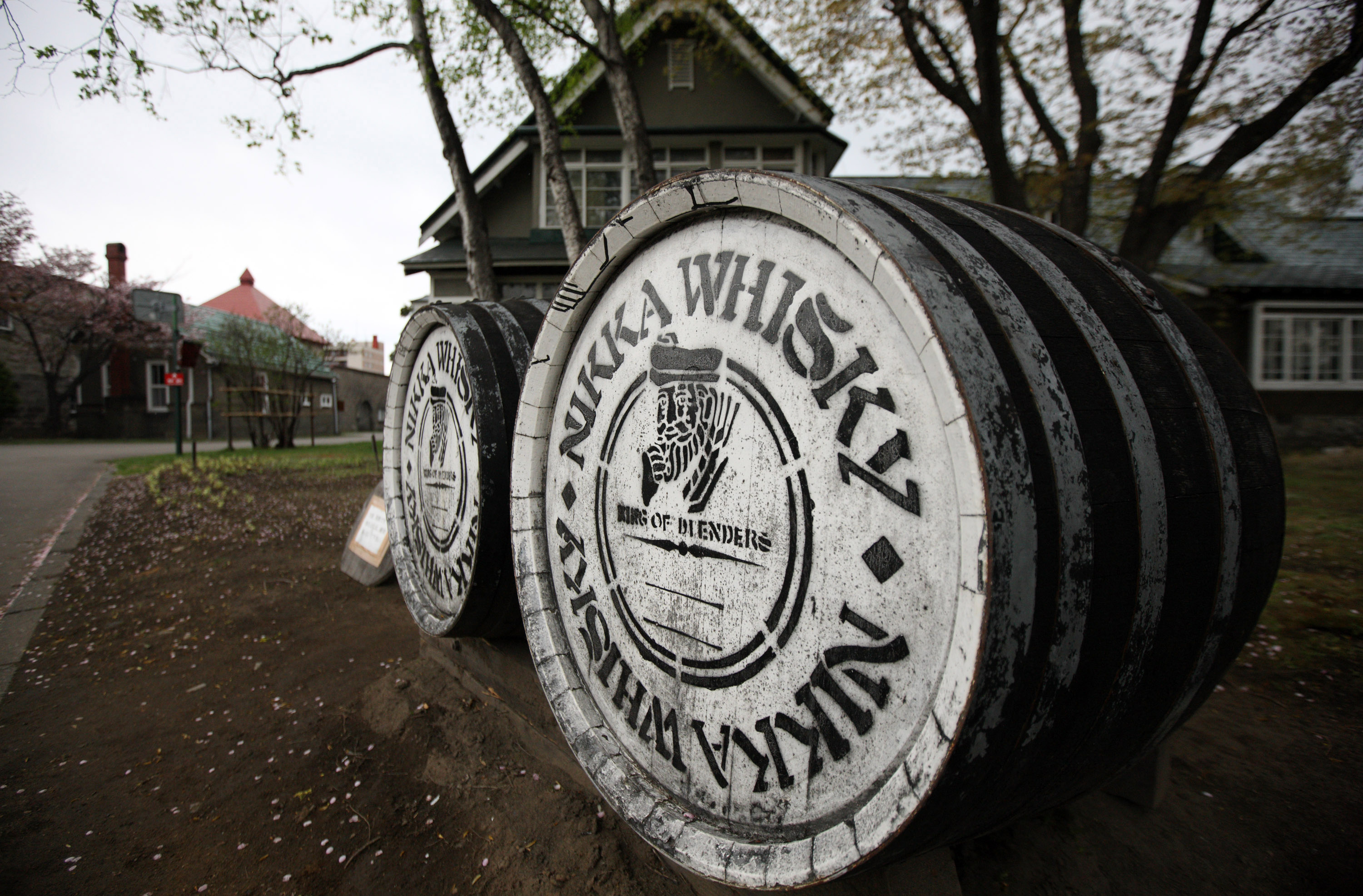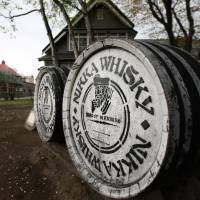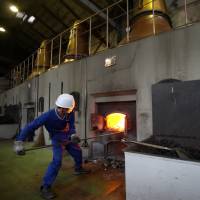I moved to Kurohime in northern Nagano Prefecture in 1980, and three years later I bought some land here and built the first house I had ever personally owned. That was made possible by the Nikka Whisky Distilling Co., for whom I did my very first Japanese television commercial back then. What a cushy job that was: drinking whisky, being taken to northern India and Nepal for some of the filming — and getting paid for it!
I'd become rather fond of Nikka whisky after Super Nikka came on the market in 1964, when I was in Japan to practice karate. In those days, like many other wannabe whisky connoisseurs, I wrongly thought Super Nikka's excellent taste was due to the fact that Scottish malt whisky was used in the blend. And please note that we're talking about "whisky" here — not "whiskey," which refers to different tipples altogether.
It wasn't until the winter of 1983, when I was invited to visit Nikka's distillery in Yoichi, Hokkaido, that I first tasted a 15-year-old Japanese malt whisky. It was superb. In fact, it was just as good as any of the Scottish malts I'd tasted — which by then was quite a lot, as I'd nobly undertaken a monthlong tour of Scottish distilleries the year before, writing for the Japanese edition of Playboy magazine. Another cushy job ... but somebody had to do it, as they say!
During that visit to the Yoichi distillery, I clearly remember looking at Takeshi Taketsuru, the adopted son of Nikka's founder, and declaring with feeling: "This is a superb whisky. You must bottle it and put it out as 100 per cent Japanese Yoichi single malt. It will turn the whisky world on end!"
Marketing experts said it would be too costly to run a TV campaign and design a new bottle. To the displeasure of the advertising company types on the same visit, though, I said there was no need to run TV commercials because, as I explained, "whisky lovers like me will write about it and its excellence will be spread by word of mouth and in the printed media."
"You don't need a new bottle design either," I told those supposed experts. "Just use your ordinary bottle. You can simply print up labels telling what's inside, then the name and fame of Nikka will spread and you'll win the trust and respect of the whisky-drinking public."
I was right, of course. Indeed, among hosts of prizes for Nikka's whiskies since then, its 17-year-old Taketsuru Pure Malt has been voted world's best blended malt in three of the last five blue-riband World Whiskies Awards held annually in London.
Nikka later converted an old stone warehouse into a whisky museum and appointed me the honorary curator. If you go there now, on a small screen just inside the entrance you can watch Old Nic actually making whisky.
Meanwhile, on Sept. 20, 2014, Japan's public broadcaster NHK began a new series in its popular morning TV drama slot comprising some 150, 15-minute episodes broadcast six days a week over six months — a series telling the story of Nikka's founder, Masataka Taketsuru (1894-1979), and his Scottish wife who was born Jessie Roberta Cowan (1896-1961), but was known as "Rita."
Titled "Massan" — Rita's pet name for her beloved husband — the series broke new ground by casting a non-Japanese in a major role, when American actress Charlotte Kate Fox was selected to play the leading lady opposite Tetsuji Tamayama.
The series was a huge hit with viewers in Japan and online around the world, and as much of it was filmed in Hokkaido and Yoichi, the distillery became flooded with visitors — tens of thousands of them — while Nikka whisky was soon so popular worldwide that stocks of the older, most famous and award-winning whiskies are running out.
Whenever I'm in Hokkaido, I always make an effort to visit my Nikka friends. Over the last 30 years I have actually made two barrels of whisky there, whose few remaining bottles are now worth a fortune — especially ones from the first barrel I made in 1986 and bottled in 2000 on my 60th birthday. What a party that was!
The Nikka plant in Yoichi is one of the most traditional malt whisky distilleries in the world, and in that statement I include Scotland. For example, back in the 1970s most Scottish distilleries used coal to heat both their wort (the sweet liquid drained from grain mash, which is fermented to make whisky) and their wash-pot (distilling) stills holding that fermented liquid. By 2002, nearly all Scottish distilleries had switched to heating stills with steam coils, although a few switched to direct bottom-heating with gas.
When I was a lad growing up in Britain, most homes were heated with open coal fires, and most big factories had by coal-fueled furnaces. In winter, you could often look down a street and see rows of domestic chimneys on either side belching smoke — with factory chimneys doing the same year-round in many towns and cities. All that coal smoke and the noxious fumes was one of the main causes of the notorious and deadly, thick "pea-soup" smog — mixes of coal smoke and fog in the air.
In Japan and the West, that's now a thing of the past. However, when I first visited the Yoichi distillery I remember feeling a kind of nostalgia at seeing thick smoke coming from the tall chimney above the still room. I later asked various locals whether the smoke bothered them. Nobody said it did, and several said the distillery smoke was just a part of the "flavor" of the town.
Some whisky-makers and tasters think that by heating the copper still directly with coal fires, you get a special kind of flavor. Because contact with the heated copper would scorch malted barley particles, though, chains known as "rummagers" are stirred around the bottom of those traditional wash-pot stills to prevent a buildup of burnt grain.
When I last visited Yoichi, which was during a lecture tour of Hokkaido in March, even though the "Massan" TV drama finished in March 2015 there was still a steady stream of visitors, including a lot from China, Malaysia and Australia and some Americans and Canadians.
I also noticed immediately that there was no smoke coming from that chimney.
Had the company finally given in to concerns about air pollution and stopped using coal, I wondered? That wasn't so, I soon discovered, and they still use it in the old, traditional way.
Nowadays, though, the smoke is treated with equipment called "dry scrubbers" that remove soot, mercury and sulfurous acidic gases.
Having lived in Britain during the 1940s, '50s and '60s, I am glad that most countries have cut the use of coal in people's homes. In order to deal with climate change, all countries have to do their best to switch to cleaner, renewable energy — but if fossil fuels are used, the exhaust must be treated to greatly reduce or eliminate pollution.
However, I confess that when my Nikka friends let me shovel in coal to one of the wash-pot still furnaces, the feel of the heat, and the sight of the glowing, blazing coals gave me a special kind of thrill. I really hope to be around so that I can taste that whisky in 10, 12 or 15 years' time.




















With your current subscription plan you can comment on stories. However, before writing your first comment, please create a display name in the Profile section of your subscriber account page.